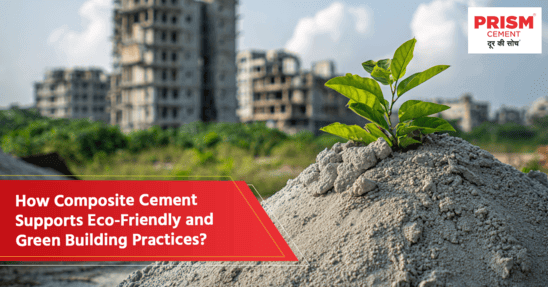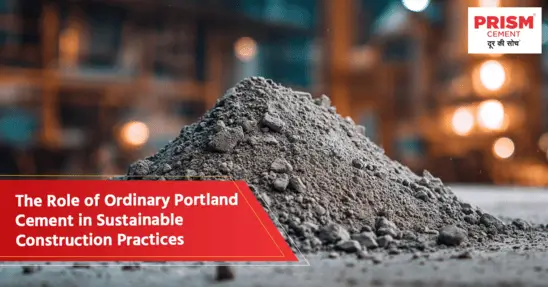In today’s construction landscape, sustainability is more important than ever. As we move towards greener and more energy-efficient building practices, composite cement has emerged as a key player in promoting eco-friendly products and green building materials. Unlike traditional cement, it blends cement with supplementary materials, such as fly ash, slag and silica fume, which can significantly reduce its environmental impact. In this blog, we’ll explore how composite cement supports eco-friendly and green building practices, offering a sustainable alternative that is both cost-effective and durable.
Environmental Benefits of Composite Cement
The shift towards using composite cement is not just about improving building performance, it's also about minimizing the environmental impact of construction. The production of traditional cement is one of the largest sources of carbon dioxide (CO2) emissions worldwide. However, composite cement offers a more sustainable solution. By incorporating industrial waste materials, such as fly ash and slag into the mix, it reduces the reliance on traditional raw materials like limestone and clay, which are used to make clinker in an energy-intensive process.
Lower Carbon Emissions
A key advantage of composite cement is its ability to reduce carbon emissions compared to traditional cement. The production of traditional cement is highly energy-intensive, with significant amounts of CO2 released during the process. By using supplementary cementitious materials (SCMs), composite cement can reduce the carbon footprint of a construction project. These SCMs, such as fly ash and slag, are byproducts of other industrial processes, so using them in composite cement helps recycle waste while also cutting down on CO2 emissions. As a result, composite cement is an eco-friendly choice for construction projects that aim to minimize their environmental impact.
Efficient Use of Industrial Waste
In addition to reducing carbon emissions, composite cement makes efficient use of industrial waste materials, giving them a second life in construction materials. Fly ash, for example, is a byproduct of coal-fired power plants, and slag is a byproduct of steel manufacturing. Instead of these materials being discarded, composite cement incorporates them into the mix, reducing landfill waste and supporting a circular economy. This recycling process helps divert millions of tons of industrial waste from landfills each year, making composite cement a more sustainable and resource-efficient material for construction.
Composite Cement in Sustainable Construction
Composite cement is increasingly used in sustainable construction, especially in green building projects. Due to its lower carbon footprint, it’s a popular choice for buildings aiming to achieve sustainability certifications, such as LEED (Leadership in Energy and Environmental Design). Not only does it contribute to a greener building, but it also supports overall energy efficiency in construction. Buildings made with it are likely to have better thermal insulation, which reduces energy consumption and helps create more energy-efficient structures.
Enhancing Durability and Lifespan of Structures
Another benefit of composite cement is its enhanced durability. The incorporation of supplementary cementitious materials improves the strength and longevity of the concrete, making structures more resistant to environmental factors such as moisture, chemicals and temperature changes. This increased durability ensures that buildings last longer, requiring less maintenance and fewer repairs over time, which can further reduce the environmental impact of the construction process. In green building projects, it helps extend the lifespan of structures, reducing the need for resource-intensive repairs or replacements.
Energy Savings in Manufacturing
Composite cement not only has eco-friendly benefits in its final use, but the production process is also more energy efficient. Since it uses less natural raw materials like limestone and clay, it requires less energy in its production process compared to traditional cement. Additionally, the use of industrial waste materials reduces the amount of energy required for manufacturing. This reduction in energy consumption contributes to lowering the overall environmental impact of the cement industry and makes composite cement a more sustainable option for construction.
Certifications and Green Building Standards
The growing demand for eco-friendly products has led to the adoption of various green building materials that help projects meet environmental standards. Composite cement is widely recognized in the green building sector, with numerous certifications and standards acknowledging its sustainability. For example, LEED and BREEAM (Building Research Establishment Environmental Assessment Method) both recognize the use of composite cement as part of their certification process. These certifications help promote the use of green building materials in construction, ensuring that buildings not only meet performance standards but also reduce their environmental footprint.
Conclusion
As the construction industry increasingly embraces eco-friendly and sustainable practices, it’s essential to choose materials that offer both strength and longevity while minimizing environmental impact. Prism Cement is committed to supporting green construction by offering high-quality cement solutions that ensure durability and efficiency in every build.
Whether you're working on residential, commercial or large-scale infrastructure projects, Prism Champion All Weather Cement is designed to withstand harsh conditions and promote long-lasting performance. By choosing Prism Cement, builders and developers actively support sustainable development while meeting growing demands for reliable, future-ready construction materials that help achieve green building certifications and lower lifetime environmental impact.
FAQs
Q1. What is composite cement and how is it different from traditional cement?
Answer: Composite cement is a type of cement made by blending Ordinary Portland Cement (OPC) with supplementary cementitious materials (SCMs) like fly ash, slag or silica fume. It differs from traditional cement by incorporating industrial byproducts, which reduces its carbon footprint and improves sustainability.
Q2. How does composite cement contribute to reducing carbon emissions?
Answer: It reduces carbon emissions by incorporating industrial waste materials that would otherwise contribute to landfill waste. These materials require less energy to process compared to traditional cement raw materials, thus lowering the overall carbon footprint of cement production.
Q3. Is composite cement as durable and strong as traditional cement?
Answer: Yes, it offers excellent durability and strength. The use of SCMs like fly ash and slag improves the concrete’s resistance to chemical attacks, moisture and temperature fluctuations, enhancing the overall lifespan and reducing maintenance.
Q4. Can composite cement be used in all types of building projects, including residential and commercial?
Answer: Yes, it is suitable for a wide range of construction projects, including residential, commercial and infrastructure developments. Its durability and eco-friendly properties make it ideal for both low and high strength applications.
Q5. What certifications or green building standards recognize the use of composite cement?
Answer: It is recognized by green building certifications such as LEED and BREEAM, both of which promote sustainability and the use of eco-friendly products in construction projects.




